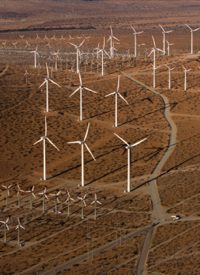
What happens when government tries to make things better? Usually, it makes things worse. Wind power sounded like a harmless enough idea.
Since the energy crisis of the mid-1970s, wind power has been one of those wacky but potentially effective ways of generating power. Windmills, after all, were one of the hallmarks of economic progress in the Middle Ages. The Dutch reclaimed polders from the sea using wind power. On the Great Plains of America, farmers used windmills to pump water, among other things.
The key, of course, was that individuals were using technologies that worked in particular situations. Geothermal power works in Iceland because of the special geography of the island. Icelanders grasped the value of geothermal power and used it effectively long before the Icelandic government regulated its use. Men built dams and constructed watermills long before nations had any formal energy policy.
Frontier Americans used animal dung, windmills, draft animals, and river currents as sources of energy, and the reasons were purely practical. These farmers naturally integrated all the tools at their disposal to survive and then to thrive. The absence of government meant that natural resources were used effectively.
Government-regulated and -subsidized wind power has become, as Gary Seifert at the Idaho National Laboratory has put it, “the train wreck or the 2000s. The train wreck is the competing resources for two national needs: energy security and national security.” The moving turbine blades of wind power projects look on the radar screens of aircraft very much like storms or other airplanes, and these turbine blacks can even cause blackouts for aircraft. The job of air traffic controllers is complicated by these wind power projects.
Mark Tholke, a regional director of wind power development for the private firm enXen, noted that the objections by the military to new wind turbines make it harder to get funding for projects: “It makes investors and banks jittery. They will increasingly view these as risky projects and push up the financial terms.” That concern is legitimate. In March, the Department of Defenses stopped a multi-billion dollar project at Shepherds Flat, Oregon, because the turbines could impair long-range radar systems. Tholke’s own company reduced the size of a wind power project from 250 megawatts to 140 megawatts to meet the concerns of defense contractors.
Making the situation more complex, the production of wind power energy can consume an extraordinary amount of land. Ed Hiserodt has calculated that in his home state of Arkansas, 494 square miles of land dedicated to wind farming would be necessary to produce the amount of electrical power from renewable sources that the federal government has planned for 2020. That would mutilate much of the natural beauty of Arkansas, producing a conflict within the environmental movement (and, presumably, within federal environmental agencies as well).
The thumping of blades, already producing what some describe as noise pollution, would be an environmental concern.
Just as troubling to environmentalists would be the slaughter of predatory birds, such as eagles and hawks, which are often rare in the wild. Already the U.S. Fish and Wildlife Service has recommended that wind turbines not be installed near wetlands, mountain ridges or shorelines where birds tend to congregate.
This could lead to the macabre scenario of certain offices of the federal government and public interest organizations suing to require an extensive environmental impact statement before the construction of wind farms which are, themselves, required by environmentalists in government to meet an artificial level of renewal energy for America.
People, without government, treasure natural beauty, wish for secure long-term energy sources, and balance a wide range of sometimes conflicting interests effectively. In place of laws, regulations, bureaus, and lawsuits, the private sector uses the marketplace. It works.



